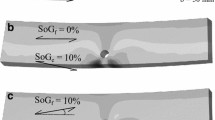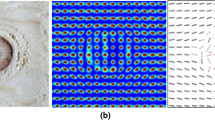Summary
In part 1 of this series, a three-dimensional, structural analysis, finite element program has been developed to predict the stress distribution in wood poles with and without spiral grain and variable material properties. This program serves as a basis for a model to predict the strength and failure location in full-size wood poles. Fundamental to this model is the ability to quantify the effects of key material and geometric properties of the pole. This paper deals with the enhancement of the program to quantify the effect of knots and their associated cross grain on the stress distribution of wood poles. The technique is based on the theoretical behavior of laminar fluid flow around an elliptical obstruction. The flow-grain analogy was employed to develop empirical relationships between knot diameter and pertinent variables (grain deviation angle near the knot and area of influence of the knot). Prior to the development of the empirical relationships, a study was conducted to determine the size and distribution of knots in Douglas-fir and western redcedar poles.
The validity of the technique to describe knot behavior is reflected in the ability of the finite element model to predict the strength and failure location of wood poles. The results suggested that the flow-grain analogy is a rational mechanism to quantify the fiber orientation near a knot. Furthermore, this technique could have meaningful implication in improving visual grading methods for wood poles.
Similar content being viewed by others
References
Bodig, J. 1986: Effect of Knots on Pole Strength. Final Report submitted to the Western Wood Preservers Institute. WSL-5. Ft. Collins, CO
Bodig, J.; Goodman, J. R. 1986: Wood Pole Properties, Vol. 3: Western Redcedar Data and Size Effect. Electric Power Research Institute-EPRI. EL-4109. Palo Alto, CA
Cramer, S. M. 1984: Failure Modeling of Wood Structural Members. Ph. D. Dissertation. Colorado State University. Ft. Collins, CO
Cramer, S. M.; Goodman, J. R. 1986: Failure modeling: a basis for the strengt prediction of lumber. Wood Fiber Sci. 18(3): 446–459
Dabholkar, A. 1980: Finite Element Analysis of Wood with Knots and Cross-Grain. Ph. D. Dissertation. Colorado State University, Ft. Collins, CO
Dashiell, J. A. 1985: Effect of Growth Characteristics on the Bending Strength of Wood Poles. M.S. Thesis, Colorado State University, Ft. Collins,CO
Franco, N. 1992: Three-Dimensional Finite Element Model to Predict Pole Strength. Ph. D. Dissertation, Colorado State University, Ft. Collins, CO
Goodman, J. R.; Vanderbilt, M. D.; Criswell, M. E.; Bodig, J. 1981: Probability-Based Design of Wood Tr Strength and Stiffness of Wood Utility Poles. Electrical Power Research Institute-EPRI. EL-2040. Palo Alto, CA
Harris, J. M. 1989: Spiral Grain and Wave Phenomena in Wood Formation. Springer-Verlag, New York, NY
Koch, P. 1972: Utilization of Southern Pine, Vol. 1: The Raw Material. USDA, Forest Service, Agricultural Handbook No. 420, Washington, D.C.
Koch, P. 1985: Utilization of Hardwoods Growing on Southern Pine Sites, Vol. 1: The Raw Material. USDA, Forest Service, Agricultural Handbook No. 605, Washington, D.C.
Kollmann, F. F. P.; Côté, Jr., W. A. 1968: Principles of Wood Science and Technology. Vol. 1. Springer-Verlag. New York, NY
Lowery, D. P.; Erickson, E. C. O. 1967: Effect of Spiral Grain on Pole Twist and Bending Strength. USDA, Forest Service Research Paper INT-35, Intermountain Forest and Range Experiment Station, Ogden, UT
Milne-Thompson, L. M. 1950: Theoretical Hydrodynamics. McMillan Co. New York, NY
Pellicane, P. J. 1983: A sampling strategy useful in full-distribution simulation. Wood Sci. Technol. 17: 279–283
Pellicane, P. J. 1984: Application of the SB distribution to the simulation of correlated lumber properties data. Wood Sci. Technol. 18: 147–156
Pellicane, P. J. 1985: Goodness-of-fit analysis for lumber data. Wood Sci. Tech. 19: 117–129
Pellicane, P. J.; Franco, N. 1994: Modeling wood pole failure — part 1: finite element stress analysis. Wood Sci. Tech. 28(6) 000–000
Phillips, G. E.; Bodig, J.; Goodman, J. R. 1981: Flow grain analogy. Wood Sci. 14(2): 55–64
Wang, Y.; Bodig, J. 1990: Strength grading method for wood poles. Journal of Structural Engineering 116(11): 2952–2967
Wangaard, F. F. 1950: Mechanical Properties of Wood. John Wiley, Inc. New York, NY
Wangaard, F. F.; Zumwalt, E. V. 1949: Some strength properties of second-growth Douglas-fir. Journal of Forrestry 47:118–124
Wood, L. W.; Markwardt, L. J. 1965: Derivation of Fiber Stress Values of Wood Poles. USDA, Forest Service, Forest Products Laboratory Research Paper No. 39, Madison, WI
Zandbergs, J. G.; Smith, F. W. 1988: Finite element fracture predictions for wood with knots and cross grain. Wood and Fiber Sci. 20(1): 97–106
Author information
Authors and Affiliations
Additional information
The authors would like to recognize the contributions of Engineering Data Management, Inc. of Ft. Collins, Colorado for their contribution of test materials and facilities for this study.
Rights and permissions
About this article
Cite this article
Pellicane, P.J., Franco, N. Modeling wood pole failure. Wood Sci.Technol. 28, 261–274 (1994). https://doi.org/10.1007/BF00204212
Received:
Issue Date:
DOI: https://doi.org/10.1007/BF00204212




